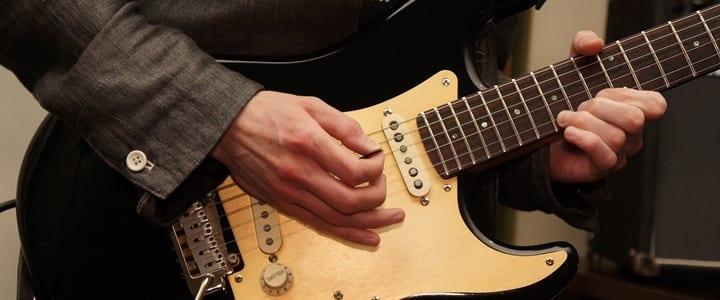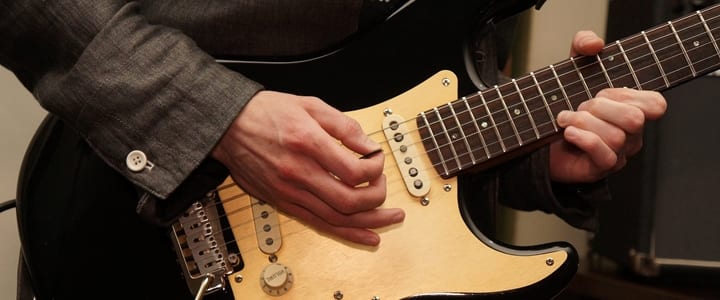Does your guitar make a shrieking noise when you sing and play? Do you want to harness its power for good? Here, guitar instructor Zachary A. explains the phenomena of guitar feedback and how it can be manipulated to enhance your music…
An Example of Feedback
The first thing that comes to mind when I think of guitar feedback is Jerry Garcia, the guitarist for the Grateful Dead. Creating a paralyzing shriek, he manipulates guitar feedback in a wizardly fashion, pushing the boundaries of the electric guitar and his amps.
Below is an example of Garcia playing around with feedback.
When you think of feedback, you’ll likely remember sitting in a class assembly – as the person at the podium conducts their speech, a loud shriek comes over the auditorium.
This screech, which is referred to as feedback, happens mainly due to a sound loop that occurs between an audio input device (a guitar or microphone, for example) and an audio output device (an amp or speaker).
What Causes Feedback?
All that’s needed for feedback to occur is the components of a basic public address system; a public address system consists of a microphone, amp, and speaker.
Feedback happens when sound is amplified out of the speakers, then travels back through the microphone, and is amplified again, and then sent back through the speakers for a second time. This loop happens so fast that it creates its own frequency, which results in the infamous shrieking noise. It’s one of the many guitar tones that you can produce.
When musicians talk on the subject of feedback, the comments are mostly negative due to this howling sound that’s produced in the middle of the song they’re trying to play. In addition to the dreaded sound loop, feedback occurs when the gain is too high in the output of an amplified instrument.
As well as ways to minimize and control feedback, there are many ways to increase the chances that feedback occurs. One main point that needs to be reiterated is that feedback occurs in a system that’s at a point of high gain and resonance. This can make it particularly challenging to control, but it can be accomplished.
How to Prevent Guitar Feedback
First, we’ll discuss ways that you can reduce the chances of feedback happening. Then, we’ll dive deeper into the ways of working magic with feedback.
One major change you can make to keep feedback down is by monitoring the amplified volume of your instrument in relation to the space that you’re playing in.
Another quick and painless way to reduce feedback is to change the position of your microphone and or speaker so that the speaker output isn’t feeding directly into the microphone. Keep the speakers further forward, closer to the audience, then the microphones further back.
Other ways to avoid the dreadful shriek are to use a directional microphone. Also, speak or sing close to the microphone; practically kissing the microphone. Also, turn off the microphone when it’s not in use, thus equalizing the signal and lowering the frequency.
Another way is to lower the speaker output. There are devices you can purchase that can be connected in between the monitor and the amp in order to reduce the amount of audio frequency that occurs.
How to Manipulate Guitar Feedback
Feedback can be used as a very interesting tool for a musician, as we heard in the Jerry Garcia video. There are a few ways to increase your chances of feedback happening so that you may utilize this technique.
For example, use a higher gauge string – they vibrate for a longer period of time and require less feedback from the output to hold a note. It’s just another way to transform your guitar sound.
Another simple cosmetic change you can make to increase the amount of sustain and feedback your instrument produces is by making the guitar as rigid as possible. If you have a bolt-on neck, make sure the screws are tight or this will reduce the sustain of the strings.
The old method to increase feedback was to connect a treble boost before the amplifier to overdrive it. Another cosmetic feedback enhancer that can be done is lowering the pickups to increase the distance between the pole pieces in the pickups and the strings.
Although some people choose to raise the pickups to produce maximum drive to the amplifier, this will decrease the amount of feedback that may occur. Unfortunately, pole pieces are magnetic and close proximity to strings will dampen the vibrations.
Now go out and create some scary horror movie sounds using feedback and get creative with it. You can use feedback to convey a vast range of sounds and emotions! Happy playing!
Post Author: Zachary A.
Zachary A. is a guitar instructor in Katy, TX specializing in beginning and intermediate students. Zachary has been playing for more than four years. He is currently earning a bachelor’s degree in music theory. Learn more about Zachary here!
Megan L.



